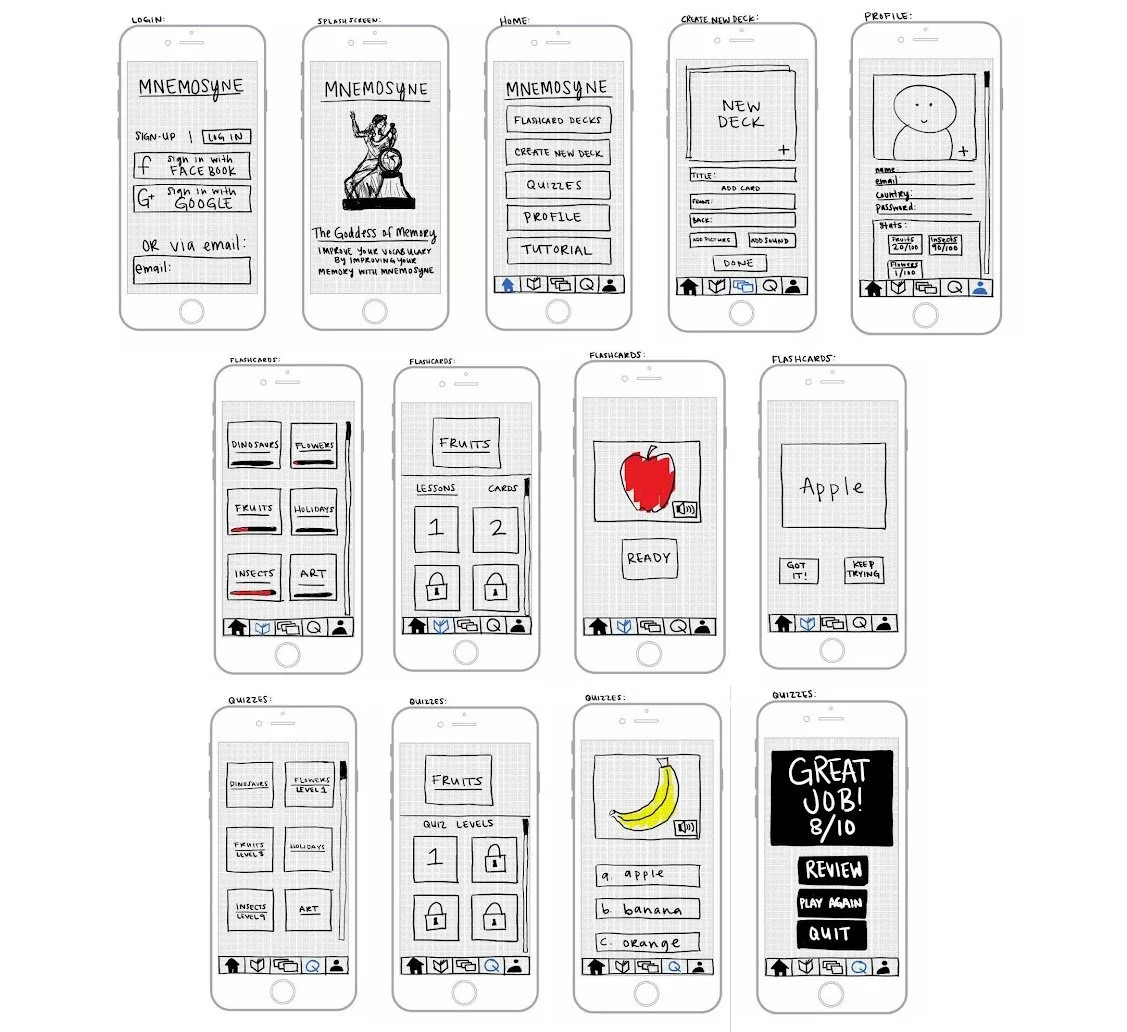MNemosyne APP
Sketches for an Educational Flash Card/Language Learning App.
In Greek mythology, Mnemosyne is the goddess of memory and where the word mnemonic device derives from. A mnemonic device is a learning technique that a formation retention or retrieval in the human memory. Mnemonics aim to translate information into a form that the human brain can retain better than its original form. Mnemonic devices can be used to remember lists, formulas, and other information that is difficult to recall.
Mnemosyne inspired me to embark on a dynamic language-learning journey, an innovative educational flashcard app designed to elevate your linguistic prowess. Mnemosyne would seamlessly blend cutting-edge technology with intuitive features, that will make studying an engaging and efficient experience.
Excellent for students of all ages and learning levels. Equipped with pre-made flash card stacks on a wide range of subjects from art history to an array of languages the user can choose from, while also allowing the user to create a personalized flash card stack to help studying for school quizzes, tests, and exams or other topics of personal interests. The user can choose from pre-programed flash card decks or design their own experience based on the subject matter. They can choose the difficulty which will quiz them and prepare them for whatever the occasion. From learning the basics of a language for a trip to a different country, to preparing for a midterm exam or giving a speech on a topic of specialty.
Features would include Adaptive Learning Algorithms, Interactive Flashcards. Spaced Repetition System, Customizable Study plans, Comprehensive Language Libraries. Gamified Learning Experiences, Offline Accessibility, and Intuitive Pronunciation Practice.
Problem:
Traditional language learning methods often lack engagement and fail to adapt to individual learning styles. Students face challenges in finding comprehensive and personalized study resources, leading to inefficiencies in their learning journey. Mnemosyne addresses these issues by providing an interactive and adaptable platform that caters to the diverse needs of learners, fostering a more effective and enjoyable language-learning experience.
Approach:
To tackle this problem, the development of Mnemosyne began with research of similar apps out there on the market that moved into a comprehensive sketching phase. The initial step involved mapping out user interfaces, features, and the overall flow of the app. This sketching process was crucial for visualizing the user experience, ensuring a user-friendly design and seamless navigation.
The approach emphasized the following key principles:
User-Centric Design: Prioritizing the user's needs and preferences, the sketches focused on creating an intuitive and visually appealing interface. User feedback played a pivotal role in shaping the final design.
Adaptive Learning Models: Incorporating adaptive learning algorithms and a spaced repetition system was a cornerstone of the development. This ensured that the app could dynamically adjust to each user's progress, optimizing the learning curve.
Comprehensive Content Libraries: The sketching phase involved outlining a diverse range of pre-programmed flashcard decks, covering various subjects and difficulty levels. This approach aimed to cater to a broad audience, including students, travelers, and enthusiasts.
Gamification Elements: The incorporation of gamified learning experiences was sketched out to add an element of fun and motivation to the language-learning process. Points, rewards, and progress tracking were integrated to make learning more engaging.
Results:
Designing Mnemosyne yielded positive results, reflected in the app's functionality and user feedback. Key outcomes include:
Improved Retention: The spaced repetition system and adaptive learning algorithms contributed to enhanced information retention, making Mnemosyne an effective tool for long-term memory building.
Versatility: Mnemosyne's comprehensive language libraries and customizable study plans proved beneficial for users with diverse learning goals and interests.
Positive User Feedback: Users praised the app for its user-friendly design, offline accessibility, and the ability to cater to individual learning preferences.
Lessons Learned:
Working on Mnemosyne provided valuable insights into designing an effective language-learning app:
Iterative Design Process: The iterative nature of the sketching process allowed for continuous improvement based on user feedback when it was being tested. Flexibility in adapting to user needs was crucial.
Balancing Complexity: Striking the right balance between comprehensive features and simplicity was a challenge. Ensuring that the app remained accessible to users of all levels required careful consideration.
Continuous User Involvement: User feedback and testing played a pivotal role throughout the development process. Regular testing and adjustments based on user insights were essential for refining the app.
Technological Infrastructure: Ensuring a robust technological infrastructure to support features like adaptive learning algorithms and offline accessibility was crucial for a seamless user experience.
In summary, the development of Mnemosyne highlighted the importance of user-centric design, adaptability, and continuous refinement in creating an effective language-learning app. The positive results and user feedback affirm the success of the approach taken during the development process.

